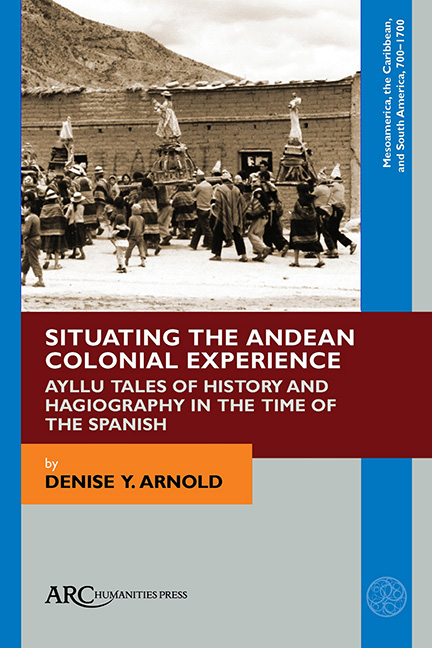 Situating the Andean Colonial Experience
Situating the Andean Colonial Experience Book contents
- Frontmatter
- Contents
- List of Illustrations
- Note About the Spelling of Toponyms and Proper Names
- Acknowledgements
- Maps
- Introduction
- PART ONE THE ORAL HISTORY OF QAQACHAKA
- PART TWO THE COLONIAL CACIQUES IN ORAL AND WRITTEN HISTORY
- PART THREE QAQACHAKA MARKA
- PART FOUR THE SAINTS APPEAR
- PART FIVE THE RELIGIOUS PRACTICES OF QAQACHAKA MARKA
- Some Conclusions
- Glossary
- Appendix A Document C of Don Franco Quispe Maraza
- Appendix B Document K of Don Franco Quispe Maraza
- Bibliography
- Thematic Index
- Index of Toponyms
Chapter 4 - A Gentleman’s Agreement Between Literate Caciques
Published online by Cambridge University Press: 22 June 2021
- Frontmatter
- Contents
- List of Illustrations
- Note About the Spelling of Toponyms and Proper Names
- Acknowledgements
- Maps
- Introduction
- PART ONE THE ORAL HISTORY OF QAQACHAKA
- PART TWO THE COLONIAL CACIQUES IN ORAL AND WRITTEN HISTORY
- PART THREE QAQACHAKA MARKA
- PART FOUR THE SAINTS APPEAR
- PART FIVE THE RELIGIOUS PRACTICES OF QAQACHAKA MARKA
- Some Conclusions
- Glossary
- Appendix A Document C of Don Franco Quispe Maraza
- Appendix B Document K of Don Franco Quispe Maraza
- Bibliography
- Thematic Index
- Index of Toponyms
Summary
Catari: Biuora grande.
Bertonio ([1612] 1984, Pt. II, 38)DON FRANCO CONTINUED straight away with an episode that related how the mixture of residents in Qaqachaka, with their ethnic and class differences, attempted to overcome these by becoming literate, learning to read and write in a nearby paying school. It is as if Don Franco senses the need to explain that some of the first Qaqachakas were literate men instead of merely campesinos. The episode tells of the acquaintance of two friends who went to this same school together: Ayra Chinche, from Pukuwata, and Lujano Choquecallati, originally from Condo before taking up his residence in Qaqachaka. Don Franco names the teacher in passing as Pedro Coñaque, although he had certain doubts about this.
This episode happens in the context of the first ancestors of the ayllu having served as mitayos in the colonial mining mit’a, when they had already sworn oaths of possession of the Qaqachaka lands. Having sworn their oaths, the Qaqachakas began to throw out the previous inhabitants of these lands, who had belonged to other ayllus. Even the important ancestor, Don Ayra, faced this kind of problem in his own path:
In the past, in the time of the grandfathers, there’d been a local school in that place. A school was already functioning there, with Ayra and Choquecallati. Ayra Chinche was from Pukuwata and Lujano Choquecallati was from Qaqachika. They’d been taught how to read by a teacher; it could have been Pedro Coñaque … They learned by paying. They’d learned there from a teacher, and made good friends with each other. Ayra and Choquecallati grew up together in that way, then they each took a wife.
I don't know if the place was called Chhala (Maize Leaf) or Risin Phuju (Neighbour's Well) … But it's there where they went to school and where they’d learned together. It's there where they used to go to school, those (two men) of Qaqachika and Pukuwata.
At one point Don Franco remarked on the long occupation that the Choquecallatis descended from this ancestor had in the place, but how they eventually changed their names to Ovando, after a baptismal godfather.
- Type
- Chapter
- Information
- Situating the Andean Colonial ExperienceAyllu Tales of History and Hagiography in the Time of the Spanish, pp. 71 - 90Publisher: Amsterdam University PressPrint publication year: 2021
